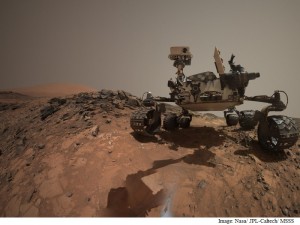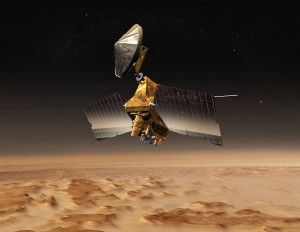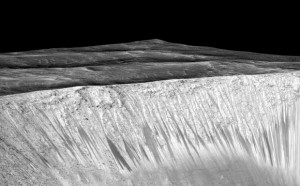Water on Mars?
That’s been known for years.
To date, there have been at least seven landers placed on the surface of the Red Planet. Those rolling robots have prowled about taking samples and analyzing data. Here’s a selfie by the most recent robot recorder, Mars Rover Curiosity.
Above Curiosity in orbit, there have been at least six circling spacecraft taking pictures and recording data. The one with the pictures causing the current stir is the Mars Reconnaissance Orbiter or MRO.
Weather working on the ground or in the air, Curiosity, MRO and their buddies have acquired a wealth of information. All that data and all those pictures have shown that Mars has ice.
Frozen Martian water is nothing new.
Flowing Martian water is new.
That’s the new news.
Take a peek at
This pic.
That’s a far distant and barren Martian ridgescape. It looks pretty inhospitable. But notice the lines down the slope fanning to darker tones. The astroscientists squinting at the picture call those lines “lineae” — an old Latin word meaning, you guessed it, “line.” Those are fancy Latin lines on the planet named for the Roman God of War.
Well, those scientists watched and watched those lines. They noticed in Mars summer, the lineae reach and extend down the slope. In Mars winter, the lineae stop where they reach, extend no more, and turn a darker shade of gray.
In another picture, the studious studiers followed gullied rivulets cutting and cascading down a sandy fall.
Abandoning their Latin, the smart guys in the back room slowly stood on their chairs with hands raised to the stars and shouted, “That’s liquid water! It flows, evaporates and leaves behind a darkened residue. It cuts, shapes and forms a carved canyonet. That’s liquid water, and it’s flowing!”
Not bad. It only took four years, but not bad. A graduate student spotted the liquid lines in 2011. In the back room, things take time.
“Was ice, now water. So what?” you say.
Good question. Simple answer.
Living organisms, as we know them, need liquid water to form, grow and survive. We humans are in the range of 60% liquid water. Yes, we are mostly water; and without water, we would be mostly gone. Considering how little liquid water there is on Mars these days (and the intermittent lineae would seem to confirm the sparcity), this may explain why our curious rover has found no wild men, white apes or Princess of Helium on Barsoom (the name Edgar Rice Burroughs gave the Mars of John Carter).
Still, there may be bugs. Bacteria may thrive where hominids dare to travel. Bacteria are simple one-celled organisms who are themselves 80-90 percent water. For their smaller size, the bacterial bugs are more resistant and less demanding than larger creatures. Importantly, though tiny, they do constitute “life” as we know it, which is why the scientists are so excited. Liquid water may mean bugs, and bacteria may mean life and a living planet.
Now those with the pocket protectors and taped black glasses are standing higher on their chairs, reaching and chanting: “Life on Mars. Life on Mars. Life on Mars.”
What’s all the fuss.
Some have known that.
Just ask Marvin the Martian.
Disney had this figured out long ago.
Grandpa Jim





